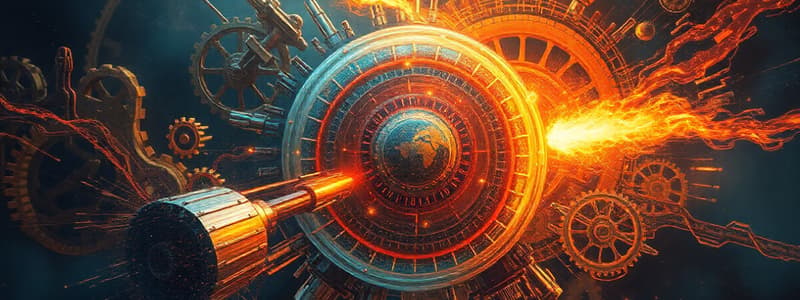Podcast
Questions and Answers
What does the first law of thermodynamics state?
What does the first law of thermodynamics state?
- Energy cannot be created or destroyed, only transformed. (correct)
- Heat always flows from cold to hot.
- Entropy of a closed system decreases over time.
- Energy can be created and destroyed.
Which of the following correctly describes uniform acceleration?
Which of the following correctly describes uniform acceleration?
- Acceleration remains constant. (correct)
- Displacement is zero.
- Velocity decreases over time.
- Forces vary significantly.
What is the formula for calculating kinetic energy?
What is the formula for calculating kinetic energy?
- KE = W/t
- KE = Fd
- KE = 1/2 mv² (correct)
- KE = mgh
What phenomenon does the Doppler Effect describe?
What phenomenon does the Doppler Effect describe?
According to Coulomb's Law, which factor increases the electrostatic force between two charges?
According to Coulomb's Law, which factor increases the electrostatic force between two charges?
What does Ohm's Law relate?
What does Ohm's Law relate?
In a series circuit, what remains the same across all components?
In a series circuit, what remains the same across all components?
Which of the following processes exemplifies conduction?
Which of the following processes exemplifies conduction?
What property describes the energy stored in an object due to its position?
What property describes the energy stored in an object due to its position?
What does the Uncertainty Principle in quantum mechanics state?
What does the Uncertainty Principle in quantum mechanics state?
Flashcards are hidden until you start studying
Study Notes
Mechanics
-
Kinematics: Study of motion without considering forces.
- Key concepts: displacement, velocity, acceleration.
- Equations of motion (uniform acceleration).
-
Dynamics: Study of forces and their impact on motion.
- Newton's Laws:
- An object at rest stays at rest; an object in motion stays in motion unless acted on by a force.
- F = ma (force equals mass times acceleration).
- For every action, there is an equal and opposite reaction.
- Newton's Laws:
-
Work, Energy, and Power:
- Work (W = Fd cos θ): energy transfer by a force.
- Kinetic Energy (KE = 1/2 mv²): energy of an object due to its motion.
- Potential Energy (PE = mgh): energy stored in an object due to its position.
- Power (P = W/t): rate of doing work.
Thermodynamics
-
Laws of Thermodynamics:
- 1st Law: Energy cannot be created or destroyed, only transformed (ΔU = Q - W).
- 2nd Law: Entropy of an isolated system always increases; heat flows from hot to cold.
- 3rd Law: As temperature approaches absolute zero, the entropy of a perfect crystal approaches zero.
-
Heat Transfer:
- Conduction: transfer of heat through direct contact.
- Convection: transfer of heat through fluid movement.
- Radiation: transfer of heat through electromagnetic waves.
Waves and Oscillations
-
Properties of Waves:
- Wavelength, frequency, amplitude, speed.
- Types: mechanical (sound) and electromagnetic (light).
-
Principles:
- Superposition: When two or more waves overlap, they combine to form a new wave.
- Doppler Effect: Change in frequency/wavelength due to relative motion between source and observer.
Electricity and Magnetism
-
Electrostatics:
- Charge: Fundamental property of matter, exists as positive or negative.
- Coulomb's Law: F = k (q₁q₂/r²): force between two charges.
-
Circuits:
- Ohm’s Law: V = IR (voltage = current x resistance).
- Series vs. Parallel:
- Series: Same current, total resistance is the sum of individual resistances.
- Parallel: Same voltage across each branch, total resistance is less than the smallest individual resistance.
-
Magnetic Fields:
- Created by moving charges.
- Right-hand rule for determining the direction of force on a charge in a magnetic field.
Modern Physics
-
Quantum Mechanics:
- Wave-particle duality: Particles exhibit both wave and particle properties.
- Uncertainty Principle: Cannot simultaneously know exact position and momentum of a particle.
-
Relativity:
- Special Relativity: Time dilation and length contraction at high speeds; E = mc².
- General Relativity: Gravity is the curvature of spacetime caused by mass.
Key Concepts
-
Principle of Conservation:
- Conservation of Energy: Energy in a closed system is constant.
- Conservation of Momentum: Total momentum before and after an event is constant.
-
Dimensional Analysis: Method to convert units and check consistency of equations.
-
Units: Understanding SI units (meter, kilogram, second, etc.) and their conversions is essential.
Applications
- Physics principles underpin technology, engineering, and everyday phenomena (e.g., mechanics in vehicles, thermodynamics in engines).
Mechanics
- Kinematics studies motion without considering forces.
- Key concepts in kinematics include displacement, velocity, and acceleration.
- Dynamics studies forces and their impact on motion.
- Newton's Laws of Motion are fundamental to dynamics:
- First Law: An object at rest stays at rest, and an object in motion stays in motion at a constant velocity unless acted upon by a net force.
- Second Law: The acceleration of an object is directly proportional to the net force acting on it and inversely proportional to its mass (F = ma).
- Third Law: For every action, there is an equal and opposite reaction.
- Work, Energy, and Power are related concepts:
- Work is the energy transferred by a force, calculated as W = Fd cos θ.
- Kinetic Energy is the energy of motion, calculated as KE = 1/2 mv².
- Potential Energy is stored energy due to position, calculated as PE = mgh for gravitational potential energy.
- Power is the rate at which work is done, P = W/t.
Thermodynamics
- Laws of Thermodynamics describe how energy and entropy behave in systems:
- First Law: Energy cannot be created or destroyed, only transferred or transformed. This is expressed as ΔU = Q - W, where ΔU is the change in internal energy, Q is heat added, and W is work done by the system.
- Second Law: Entropy, a measure of disorder, always increases in an isolated system. Heat flows spontaneously from hotter to colder objects.
- Third Law: As temperature approaches absolute zero, the entropy of a perfect crystal approaches zero.
- Heat Transfer occurs through three mechanisms:
- Conduction: Heat transfer through direct contact between substances.
- Convection: Heat transfer through the movement of fluids (liquids or gases).
- Radiation: Heat transfer through electromagnetic waves, like the sun's warmth.
Waves and Oscillations
- Waves are disturbances that transfer energy. They have properties like:
- Wavelength: The distance between two consecutive crests or troughs.
- Frequency: The number of waves passing a point per second.
- Amplitude: The maximum displacement from the equilibrium position.
- Speed: The rate at which the wave travels.
- Types of Waves:
- Mechanical waves require a medium to travel (e.g., sound waves).
- Electromagnetic waves do not require a medium and travel at the speed of light (e.g., light waves).
- Principles of Wave Behavior:
- Superposition: When waves overlap, they combine to form a new wave.
- Doppler Effect: The perceived change in frequency or wavelength of a wave due to the relative motion between the source and the observer.
Electricity and Magnetism
- Electrostatics deals with stationary charges:
- Electric Charge: A fundamental property of matter, existing as positive or negative.
- Coulomb's Law: Describes the force between two point charges, F = k (q₁q₂/r²).
- Electric Circuits: Conductors that allow for electrical current flow:
- Ohm's Law: Relates voltage, current, and resistance: V = IR.
- Series Circuits: Components are connected in a single path. The current is the same throughout, and the total resistance is the sum of individual resistances.
- Parallel Circuits: Components are connected in separate branches. The voltage is the same across all branches, and the total resistance is less than the smallest individual resistance.
- Magnetic Fields: Regions of space where magnetic forces are exerted:
- Moving Charges: Create magnetic fields.
- Right-Hand Rule: Used to determine the direction of the magnetic force on a charge moving in a magnetic field.
Modern Physics
- Quantum Mechanics: Describes the behavior of matter and energy at the atomic and subatomic levels:
- Wave-Particle Duality: Particles exhibit both wave and particle characteristics.
- Uncertainty Principle: It is impossible to simultaneously know both the exact position and momentum of a particle.
- Relativity: Deals with the relationship between space, time, and gravity:
- Special Relativity: Explains the effects of motion at speeds close to the speed of light, including time dilation and length contraction. Also demonstrates the famous equation E = mc², relating energy (E) to mass (m) and the speed of light (c).
- General Relativity: Explains gravity as a curvature of spacetime caused by mass and energy.
Key Concepts
- Principle of Conservation:
- Conservation of Energy: In a closed system, the total energy remains constant.
- Conservation of Momentum: The total momentum of a system remains constant before and after an event.
- Dimensional Analysis: A technique used to check the consistency of equations and convert units.
- Units: Understanding and using the International System of Units (SI units) is crucial for scientific calculations.
Applications
- Physics principles are essential in technology, engineering, and understanding everyday phenomena. Examples of these include mechanics in vehicles, thermodynamics in engines, and electricity in power systems.
Studying That Suits You
Use AI to generate personalized quizzes and flashcards to suit your learning preferences.



